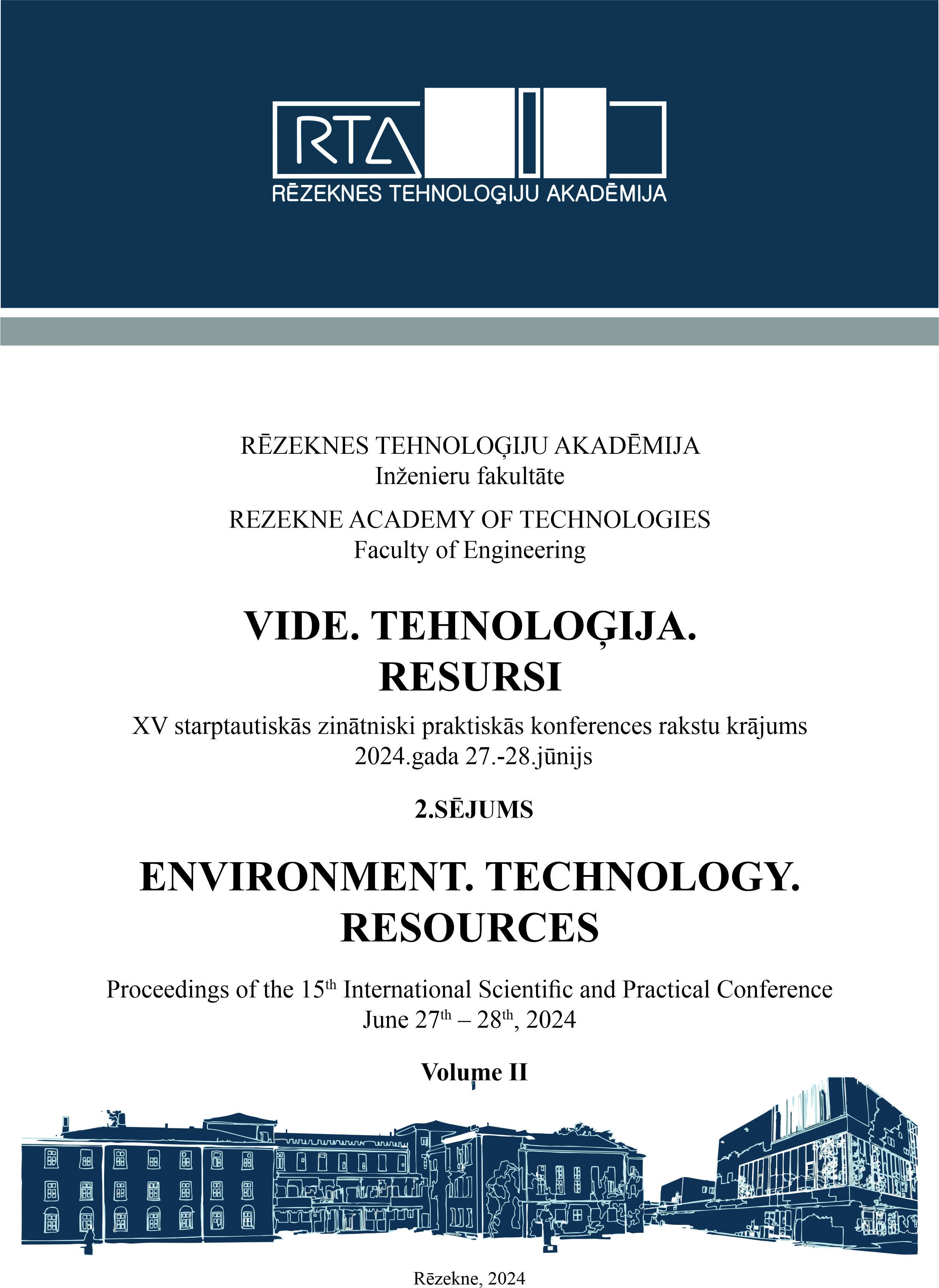APPLICATION OF AI-ENHANCED IMAGE PROCESSING METHODS FOR EDUCATIONAL APPLIED PHYSICS EXPERIMENTS
DOI:
https://doi.org/10.17770/etr2024vol2.8068Keywords:
Image Processing, Interdisciplinary Connections, Experiments AutomationAbstract
This article examines the use of an AI-powered automated image analysis system. The system's purpose is to enhance the workflow of students during applied physics laboratory experiments, helping them analyze images and perform accurate microobject counting. On the software side, the system incorporates machine learning algorithms for visual processing applications using Python and its’ extension libraries – CV2, Tensorflow, Keras, SkLearn etc.. The hardware consists of a camera and microprocessor, which, in conjunction with the image processing software, perform microobject recognition and counting in real-time. The goal is to automate applied physics laboratory experiments in which the counting of microobjects, be it organic or human-made, is usually done manually. During these applied physics laboratory experiments and with the aid of this system, students are exposed to a modern workflow, further preparing them for future work environments, teaching them about process automation, and further increasing their interest in micro-scale related science subjects. Automation using image processing technology combined with automatic data logging from images allows for fast and accurate micro-object counting.
References
J. Aaron, T.L. Chrew, (2021), A guide to accurate reporting in digital image processing – can anyone reproduce your quantitative analysis? Journal of Cell Science, Volume 134, Issue 6. https://doi.org/10.1242/jcs.254151
M. Buttarello and M. Plebani. Automated Blood Cell Counts: State of the Art. American Journal of Clinical Pathology, 130(1):104–116, 2008.
I. Cinar, Y. S. Taspinar, Detection of Fungal Infections from Microscopic Fungal Images Using Deep Learning Techniques, proceedings of 11th International Conference on Advanced Technologies (ICAT'23), Istanbul-Turkiye, August 17-19, 2023. [DeFungi]
Defungi Dataset https://ui.adsabs.harvard.edu/abs/2021arXiv210907322P/ [Accessed: Dec. 17, 2023]
I. Goodfellow, Y. Bengio, A. Courville, & Y. Bengio, (2016). Deep learning (Vol. 1). MIT press Cambridge.
A. Gulli, & S. Pal, (2017). Deep learning with Keras. Packt Publishing Ltd.
R. Hayes, G. Pisano, D. Upton, and S. Wheelwright, Operations, Strategy, and Technology: Pursuing the competitive edge. Hoboken, NJ: Wiley, 2005.
K. He, X. Zhang, S. Ren, & Sun, J. (2016). Deep residual learning for image recognition. In Proceedings of the IEEE conference on computer vision and pattern recognition (pp. 770-778).
B. Herman and J. J. Lemasters (eds.), Optical Microscopy: Emerging Methods and Applications. Academic Press, New York, 1993, 441 pp.
L. Howell et al. (2021), Multi-Object Detector YOLOv4-Tiny Enables High-Throughput Combinatorial and Spatially-Resolved Sorting of Cells in Microdroplets, Advanced Materials Technologies https://doi.org/10.1002/admt.202101053
R. Lücking, S. D. Leavitt, & Hawksworth, D.L. Species in lichen-forming fungi: balancing between conceptual and practical considerations, and between phenotype and phylogenomics. Fungal Diversity 109, 99–154 (2021). https://doi.org/10.1007/s13225-021-00477-7
B. Matsumoto Cell Biological Applications of Confocal Microscopy, Second Edition (Methods in Cell Biology) (Methods in Cell Biology, 70).
L. Picek, M. Šulc, J. Matas, J. Heilmann-Clausen, T.S. Jeppesen, E. Lind. (2022), Automatic Fungi Recognition: Deep Learning Meets Mycology. Sensors. 2022; 22(2):633. https://doi.org/10.3390/s22020633
J. Poomcokrak and C. Neatpisarnvanit. Red Blood Cell Extraction and Counting. In Proceedings of the 3rd International Symposium on Biomedical Engineering, 199–203, 2008.
G. P. M. Priyanka, O. W. Senevirante, R. K. O. H Silva, and W. V. D. Soysa amd C. R. De Silva. An Extensible Computer Vision Application For Blood Cell Recognition And Analysis, 2006
H. Qassim, A. Verma and D. Feinzimer, "Compressed residual-VGG16 CNN model for big data places image recognition," 2018 IEEE 8th Annual Computing and Communication Workshop and Conference (CCWC), Las Vegas, NV, USA, 2018, pp. 169-175, doi: 10.1109/CCWC.2018.8301729. [VGG16]
A. Rohani, M. Mamarabadi, Free alignment classification of dikarya fungi using some machine learning methods. Neural Comput & Applic 31, 6995–7016 (2019). https://doi.org/10.1007/s00521-018-3539-5
O. Ronneberger, P. Fischer, & T. Brox, (2015). U-net: Convolutional networks for biomedical image segmentation. In International Conference on Medical image computing and computer-assisted intervention (pp. 234-241).
S. A. Sanchez et al., 2020 IOP Conf. Ser.: Mater. Sci. Eng. 844 012024. doi 10.1088/1757-899X/844/1/012024 [tensorflow]
T. Shi, N. Boutry, Y. Xu and T. Géraud, (2022) Local Intensity Order Transformation for Robust Curvilinear Object Segmentation, in IEEE Transactions on Image Processing, vol. 31, pp. 2557-2569, 2022, doi: 10.1109/TIP.2022.3155954.
F. K. Shler, B. A. Sallow, (2022), Disease Diagnosis Systems Using Machine Learning and Deep learning Techniques Based on TensorFlow Toolkit: A review. AL-Rafidain Journal of Computer Sciences and Mathematics, 16 (1), 111-120. doi: 10.33899/csmj.2022.174415
K. Simonyan, & A. Zisserman. (2014). Very deep convolutional networks for large-scale image recognition. arXiv preprint arXiv:1409.1556.
Y. Skaf, R. Laubenbacher, “Topological data analysis in biomedicine: A review, Journal of Biomedical Informatics,Volume 130, 2022, 104082,mISSN 1532-0464, https://doi.org/10.1016/j.jbi.2022.104082.
S. S. Sumit et al 2020 J. Phys.: Conf. Ser. 1529 042086, doi 10.1088/1742-6596/1529/4/042086
O. Wu, F. Merchant, K. Castleman (2008). Microscope image processing. Academic Press is an imprint of Elsevier, UK, 2008. ISBN13 9780123725783
H.Yang,, J. Ni, , J. Gao, et al. A novel method for peanut variety identification and classification by Improved VGG16. Sci Rep 11, 15756 (2021). https://doi.org/10.1038/s41598-021-95240-y [VGG16]
A. Gulli, & S. Pal, (2017). Deep learning with Keras. Packt Publishing Ltd.
Downloads
Published
Issue
Section
License
Copyright (c) 2024 Eivin Laukhammer, Eugenijus Mačerauskas, Andzej Lučun, Antoni Kozič, Romanas Tumasonis

This work is licensed under a Creative Commons Attribution 4.0 International License.



